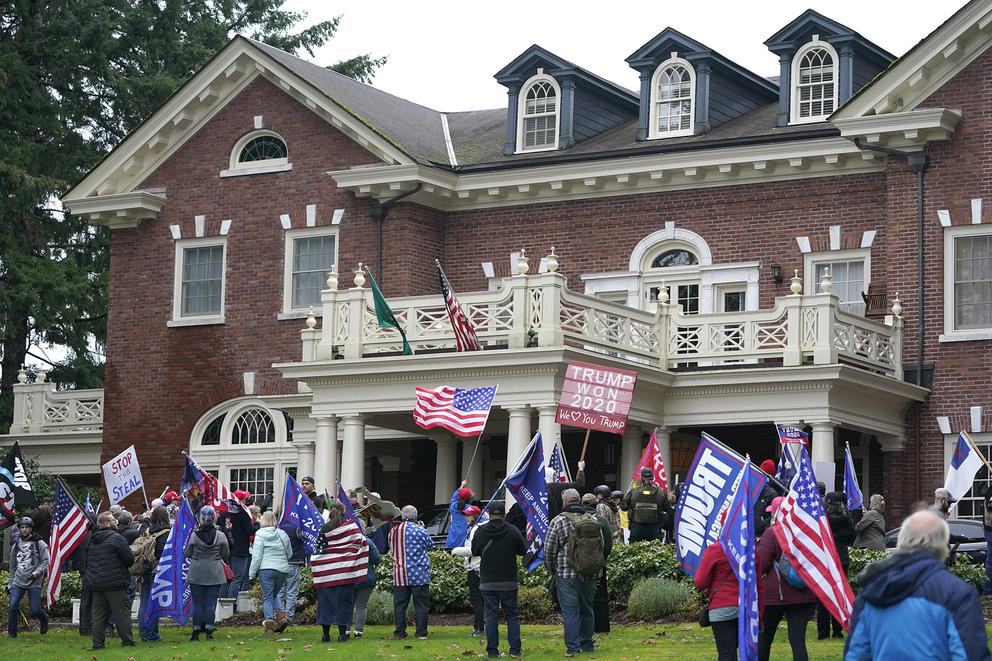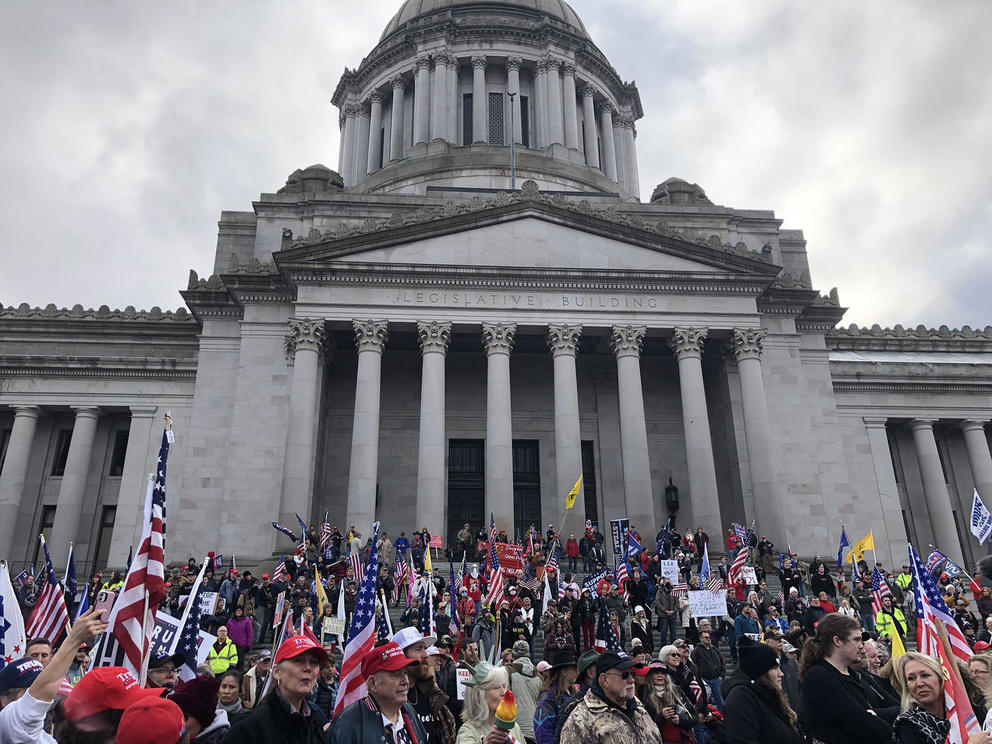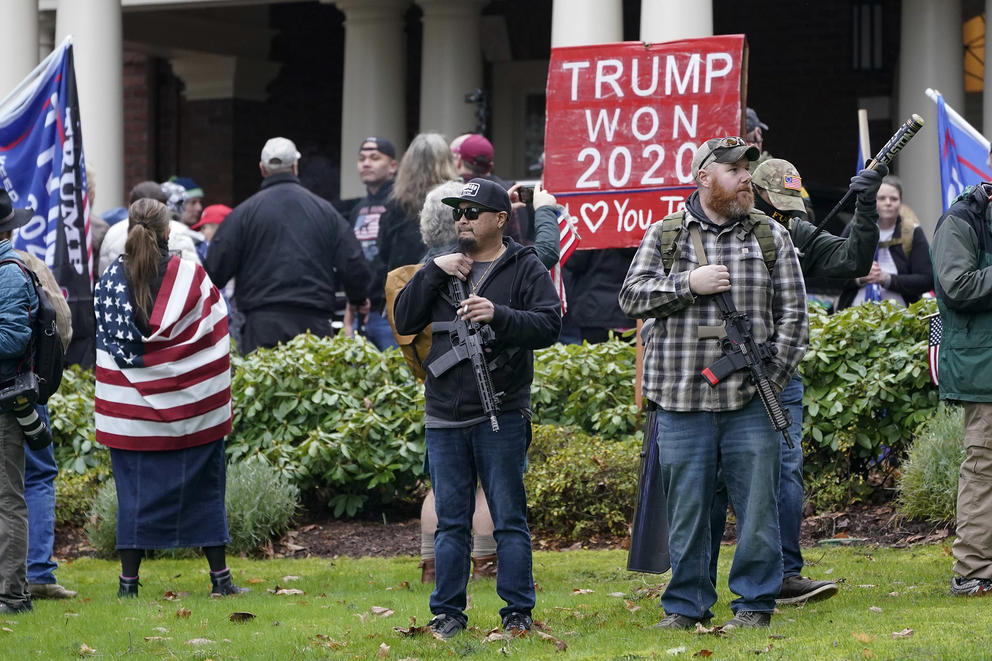Chris Loftis, director of communications for the Washington State Patrol, remembers that day well. “I've never been prouder of these people who came together and said look, there's a real and present danger to the people, the processes and the places of democracy,” Loftis said in a recent phone interview. “We're going to step into that breach and create a line that you will not pass.”
Shauna Sowersby, now a state government reporter for McClatchy, was a freelance reporter for Crosscut that day in Olympia. “It was just … such a scary day,” Sowersby said. She remembered a moment that afternoon when someone armed with an assault rifle was speaking to the crowd and urging protesters to kill all the reporters there. “That was probably the most terrifying moment,” Sowersby remembered.
Her reporting (alongside that of David Kroman and Melissa Santos) and tweets captured the day’s chaotic events – which ramped up from a protest into a tense altercation in which armed protesters stood outside the doors of the mansion where Gov. Jay Inslee and his wife reside, shouting at the handful of law enforcement officers stationed there.
Loftis said that two years later, only four people have been arrested for the most egregious offenses that day (and charges against one of them were later dropped).
And the Washington State Patrol, in cooperation with the Washington State Department of Enterprise Services – which manages security on the state capitol campus – have rethought their approach to keeping the Legislature, the governor’s mansion, and the Washington Supreme Court safe, Loftis said.
“The number of the personnel on site 24/7 has been ramped up appreciably,” he said, although he declined to provide specific details. The state has added concrete planters, fencing, and surveillance equipment – as well as revised planning – to help prevent a similar upheaval.
“It all gives us the ability to respond to a crisis as quickly as possible and hopefully to mitigate and reduce chances of there ever being a crisis in the first place,” he said.
In addition, the Legislature passed a bill in 2021 banning the open carry of guns on the capitol campus.
The events of Jan. 6, 2021, in Olympia began about noon, at about the same moment the nation watched a crowd of election deniers smash windows in the U.S. Capitol building, violently breach defenses, and nearly stop the certification of the election while members of Congress sheltered in place.
Sowersby said that at first, the protest on the legislative building’s north steps was energetic, but not unusually so.
“It started off pretty normal,” she said, but noted that as people in the crowd became more aware of events in Washington, D.C., the tone began to change. “They started making all these claims of election fraud, and it started getting more and more heated.”
Tensions in Olympia had actually been simmering for more than a month prior. Armed groups of right-leaning protesters regularly expressed concern about the state’s COVID-19 restrictions and unfounded accusations of election fraud. They clashed with left-leaning protesters during several weekends in early December. Sowersby witnessed a shooting on the state capitol campus on Dec. 12, 2020.
She said members of the Proud Boys and leftist anti-fascist groups had been brawling that afternoon, and when some of the leftist protesters began hurling rocks at a member of the Proud Boys who was trying to get into his car, he opened fire.
“It didn’t even seem like he was aiming at anything,” she said. “He kind of shot wildly into this group of people.” One protester was shot, but survived. “It was quite something to see someone that pale and bleeding out. And people trying to get him into a car and to the hospital. It was crazy.”
Loftis said the State Patrol had to activate its rapid deployment force on or near the capitol campus 13 times in response to armed and clashing protesters from the onset of COVID restrictions in early 2020 until the events of Jan. 6.
“I don't want to be dismissive,” he said, “but Jan. 6 wasn’t a period at the end of the sentence, but an exclamation point in the middle of a paragraph.” He said the level of violent activity hadn’t been seen in the capital since the 1960s or perhaps ever.
That violence was definitely on Sowersby’s mind when some of the speakers at the Jan. 6 rally started using more strident language. Joey Gibson, a Clark county resident and founder of the right-wing group Patriot Prayer, spoke to the crowd, Sowersby said, telling protesters about claims of election fraud, and, she said, “how the media's in on this and they think you're stupid – really getting the crowd riled up.”
Sowersby said that at about 2:45, the final speaker, Tusitala “Tiny” Toese, a well-known right wing activist also from Clark County, urged the crowd to march toward the governor’s mansion.
It was about this time that one protester who had earlier fired up the crowd by telling them “The time to talk is over, they’re storming the Capitol, it’s war now,” shouted out something about killing all the reporters there. “And everybody in the crowd cheered,” Sowersby said.
The protesters, armed with everything from assault rifles to a baseball bat studded with nails, arrived at the gates of the governor’s mansion and began shaking the iron fence. According to Linda Kent, a spokesperson from the Department of Enterprise Services, some of the rioters succeeded in breaking the lock on a door through the gate, and after opening it, the crowd streamed into the grounds below the mansion.
Only a handful of state troopers were on hand, and Sowersby remembers one woman officer being surrounded by the crowd and then managing to retreat back toward the mansion.
It was around this time that Sowersby was confronted by Damon Huseman, an armed protester from Seattle who had earlier confronted another journalist and photographer and made threatening statements to other members of the media. Huseman was later arrested, and in March 2021 pleaded guilty to third-degree assault, criminal trespass and harassment.
The crowd shouted at the officers stationed at the doors of the mansion, Sowersby said, and after being questioned by several protesters and fearing for her safety, she moved away from the protesters to join a group of other journalists. By about 3:15, she remembers, more police arrived and the crowd began to disperse.
Supporters of President Trump, including those with guns and a bat, stand outside the Governor's Mansion after breaching a perimeter fence, Wednesday, Jan. 6, 2021, at the Capitol in Olympia following a protest against the counting of electoral votes in Washington, D.C., affirming President-elect Joe Biden's victory. The area was eventually cleared by police. (AP Photo/Ted S. Warren)
In the weeks following, more than 600 members of the Washington National Guard were activated and stood guard over the capitol campus until after the presidential inauguration on Jan. 20, 2021.
Loftis said those moments, from the time when the crowd breached the gates until after the inauguration, were among the highlights of his career. “I’m proud of all these people, from the governor to the strangers in khaki uniforms I saw walking by my office in those days,” he said.
“I was proud to be a small part of saying: This stops here. You're not going to take over this building. You're not going to interfere with the process and these people making laws and debating ideas,” he said.
In addition to Huseman, one other person was charged in 2021 with assault and trespass, and in January 2022, Tusitala Toese was arrested and charged with assault, obstruction of justice, and criminal trespass for his actions on Jan. 6. His prosecution is ongoing and has been delayed because of other charges he faces in Oregon.
Although things have quieted significantly since those tense days two years ago, Sowersby said the potential for a similar conflict feels very real. “It scares me a lot. I was kind of naive before all this stuff went down,” she said.
This story has been corrected to show that protesters broke the lock on the gate to the governor's mansion, according to a state official.





